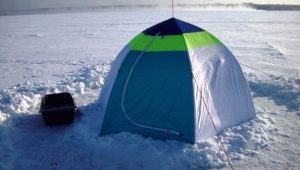Camping tents: description, types and tips for choosing them
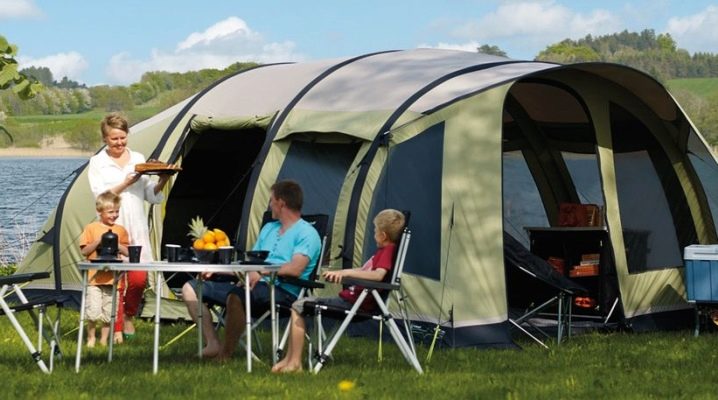
Camping tents are designed for a long comfortable stay in nature. They are distinguished by ease of use and are highly valued by lovers of unorganized recreation.

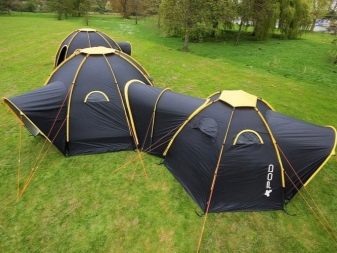
Peculiarities
The camping tent is a mobile building of a large area with high ceilings, capable of accommodating from 2 to 12 vacationers. This design allows a person to stand in them to their full height, but at the same time imposes certain restrictions on their use.
For example, for a hiking trip that involves a long hike, camping tents are not suitable. This is due to the fact that in the folded state they are quite large and heavy, and can be moved to the installation site exclusively by transport. But when organizing a tent camp or tourist camp, camping models are simply irreplaceable.
For the most part, they have an entrance vestibule and several separate rooms, which make it possible to comfortably accommodate a sufficient number of people.


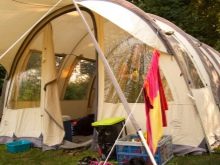
Camping tents are often used in water tourism as well. However, the boat or kayak must be designed for a volumetric product and have an appropriate carrying capacity.In addition to the presence of a vestibule and several separate rooms, camping tents boast ceilings from 1.6 to 2 meters, an excellent ventilation system and reliable protection from wind and rain.
The products have a collapsible frame structure that allows you to quickly set up the camp and also quickly assemble it, and clear instructions that facilitate installation. The most modern expensive models have an automatically folding frame. This significantly reduces the installation time and allows you to unfold the tent in just 3-5 minutes.
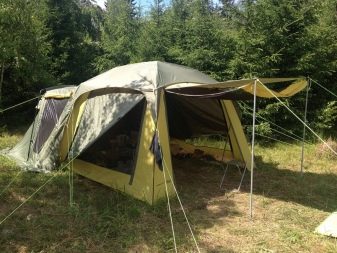
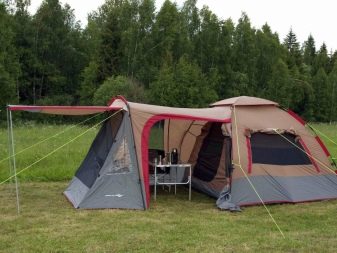
A distinctive feature of camping tents is a very spacious vestibule, where in case of bad weather you can put a common table and spend time with a big company. Most models have three compartments with a capacity of two to four people, which allows you to simultaneously accommodate up to 12 adults for the night. Such models are very convenient for families with children, who are usually allocated a separate room.
Even though there is no soundproofing in camping tents, the possibility of separate accommodation, as a rule, makes children very happy.

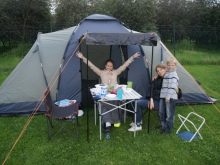
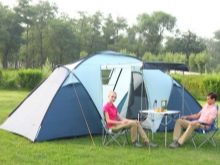
An important characteristic of camping models is the presence of ventilation. Usually external partitions and a ceiling are made of the breathable materials and are closed on a lightning. This contributes to normal air exchange inside the structure and does not allow mosquitoes and other blood-sucking insects to penetrate inside the tent.
The door to the vestibule in most cases has a double version, where a dense waterproof fabric is used as the outer layer, and the lower one is represented by a mosquito net. For more expensive models, additional mosquitoes are installed on the doors of each of the rooms coming from the vestibule.
Moreover, there is a mosquito net on all ventilation windows, and a protective “skirt” is located around the perimeter of the tent. Thanks to such comprehensive measures, insects do not have the slightest chance to get inside the structure and disturb the sleep of vacationers.
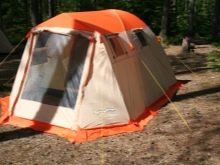
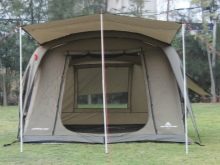
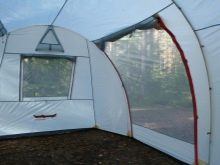
Considering the design features of a camping tent, one cannot fail to mention the number of exits. So, when using the structure in a hot and stuffy climate, it is better to choose a model with two entrance doors located at different ends of the tent. This will allow you to open both doors at the same time on especially hot days and provide a little breeze.
As for the floor, it is necessarily available in each sleeping compartment, but the common vestibule is not always equipped with it. More often, the vestibule is considered precisely as a “dirty” zone, where you can sit at the table in the rain without taking off your street shoes, but take off your shoes before entering the bedroom. Regarding the weight of the products, the following can be said: camping models are among the heaviest tents, so they can only be transported by car or other vehicle.
However, despite the heavy weight, when choosing a model, it is better to focus on more spacious structures, which will comfortably accommodate more people.
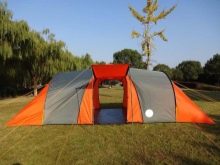
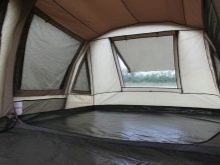

Manufacturing materials
For the production of camping tents, high-quality and durable materials are used. The frame of the structures is made of fiberglass, aluminum or steel. Steel structures are more reliable and stable, they perfectly keep their original shape and do not break from the wind.
Steel is usually used to produce high and spacious tents with high windage. Flexible aluminum frames weigh much less and are easy to install.For greater strength and rigidity, fiberglass components are wrapped in a special braid, after which they are in no way inferior in strength to aluminum ones.
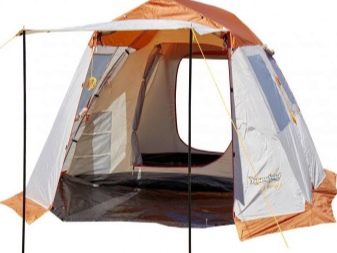
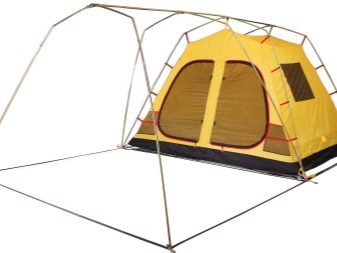
As a material for external walls and internal partitions, tarpaulin and synthetic fabrics are used. Tarpaulin tents are better breathable and, despite the "denseness" of the material, are still in high demand. The reason for this is the ability of the tarpaulin to let out the air heated inside the building, thereby preventing stuffiness. With this quality, tarpaulin models compare favorably with polyester ones, which heat up quite a lot under the sun's rays.
The disadvantage of canvas tents is the behavior of the material during rain. In general, the tarp retains water drops quite well. This is due to the fact that when wet, natural fibers swell and close together, forming a rather dense structure.
Water, falling on such a surface, cannot seep inside and begins to roll down the surface. Those few drops that still managed to get inside are held by surface tension and remain on the inside of the tarp. This happens until someone touches or leans against the wet walls or ceiling. In this case, the integrity of the water film is broken, and water begins to run into the room.
In this regard, the use of canvas models is most appropriate in a dry, hot climate with a minimum amount of prolonged rains.
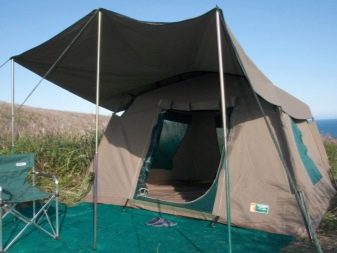
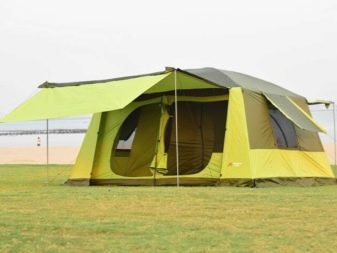
Of the semi-synthetic fabrics, also sometimes used for the manufacture of camping tents, a blended fabric has good performance characteristics, which, in addition to artificial fibers, contains cotton threads.
Products made from such material are distinguished by good ventilation and weigh much less than tarpaulin analogues. However, the main and most common material for making camping tents is polyester, with polyurethane impregnation applied to its inner surface. Such material has the highest water resistance and does not let water through even during heavy rain.
The disadvantage of the fabric is the fact that it practically does not allow air to pass through, which is why polyester models are necessarily equipped with ventilation windows.
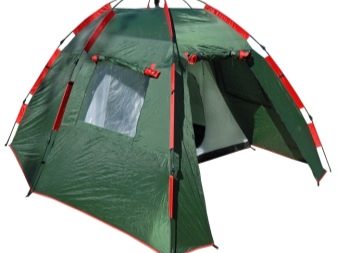
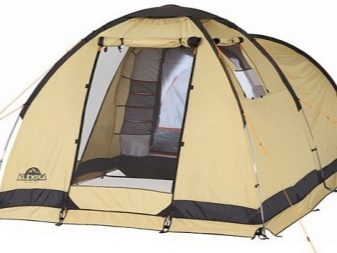
The floor in expensive camping models is also made of polyester or nylon impregnated with polyurethane, and in more budget options, reinforced polyethylene is used. This material is not ideal: it is noticeably heavier than nylon and rustles when walking, but it significantly reduces the cost of the tent and lasts a long time.


How are they different from tourist and trekking?
The main difference between a camping tent and a tourist tent is its weight and dimensions. So, if with a tourist model, the mass of which does not exceed 2-4 kg, you can make many kilometers of transitions, then with a camping one, things are different. The weight of the smallest model is 7 kg, and 2-3-room large samples weigh more than 20 kg, and it is quite difficult to carry such a burden on yourself.
The next difference is that camping tents are tall enough to allow you to enter them without bending over. Tourist models are designed exclusively for overnight stays and do not imply a full-length person in them. This is due to the fact that in order to better withstand squally winds and other extreme weather events, they must have streamlined shapes and be quite low.
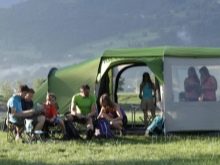

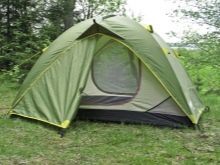
Another difference is building capacity. So, if a camping tent can accommodate up to 12 people, then a tourist tent is more often designed for three. In addition, camping models are designed for a long stay, and therefore are equipped with a variety of organizers in the form of hanging or folding shelves and pockets. This allows you to conveniently place a book, a flashlight, wash accessories and other things needed in nature.
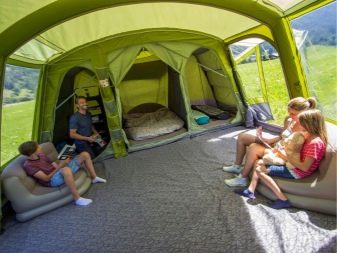
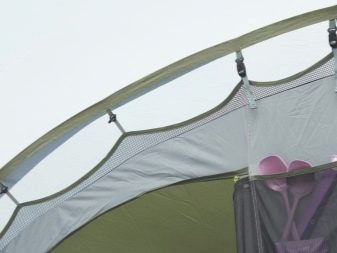
If we compare camping tents with trekking ones, then the latter weigh up to 5 kg, can accommodate a maximum of 4 people, do not have a vestibule (if there is one, it is very small) and can be easily carried in a backpack.
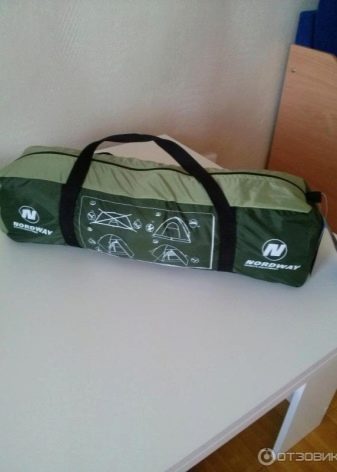

Varieties
Camping tents are classified according to several criteria, the main of which are the shape of the models and the layout of the internal space. According to this criterion, products can be divided into three categories.
- Tunnel model ("half-barrel") is a spacious room with a large vestibule and a roomy room. The disadvantage of the design is not too high resistance to side wind, which is why it must be secured with stretch marks and pegs.

- Gable model Today it is not widely used and is considered quite outdated. However, some manufacturers remain true to the classic forms and continue to produce their products, stylizing them, for example, as Indian huts.These tents are easy to set up and are quite suitable for a comfortable stay.
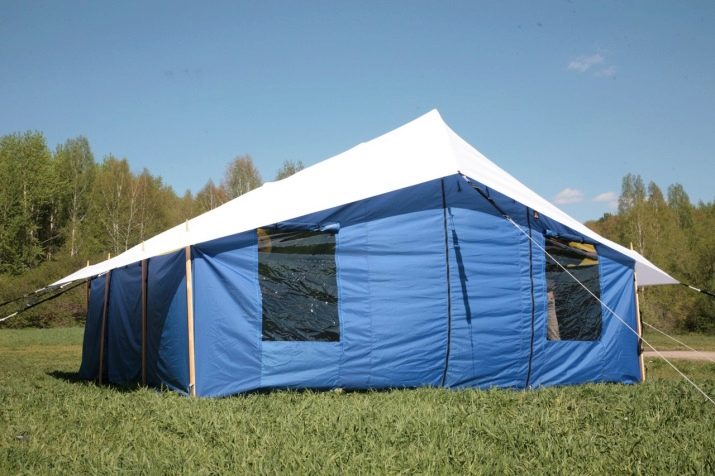
- Hemispherical models are considered the most reliable designs. They are highly wind resistant, do not require guy lines and can be installed by one person. As for the useful area, it is slightly smaller than that of the "half-bars", but this does not detract from the other advantages of the "hemispheres", such as ergonomics, streamlining and convenient layout.
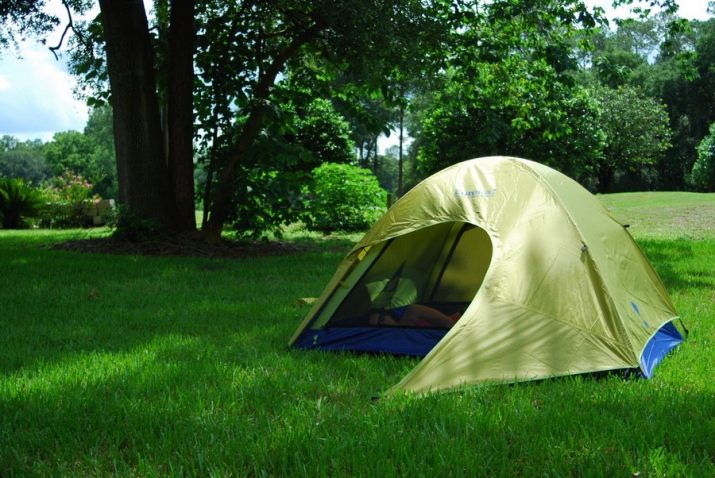
By the way, the internal layout is the next criterion for classifying camping tents and there are several types. The simplest design is considered to be a tent with one sleeping compartment and a vestibule, and the most convenient and practical is a three-room model. The advantage of the latter is the complete autonomy of each sleeping compartment, a separate entrance and the absence of neighbors behind the wall. However, not all models have a modular design, and in many of them the rooms are formed by means of removable partitions installed at the request of vacationers.
Another criterion for classifying tents is their seasonality. Models are divided into summer and universal, or "three-season", allowing them to be used not only in summer, but also in the off-season.

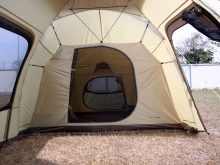
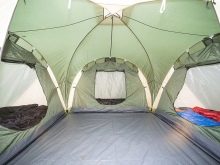
Overview of the most popular models
The modern market of tourist equipment presents a huge selection of camping tents, the most popular of which will be discussed below.
- One of the leaders is the Maverick Slider automatic tent. Thanks to the automatic frame, the installation time of this model will take no more than three minutes. The tent consists of a pair of double rooms and a spacious vestibule between them.Moreover, its area makes it possible to equip an extra bed there, thereby turning a 4-seater tent into a 5-seater tent. The model is equipped with two ventilation windows, has two entrances and is made of polyester. The floor of the model is distinguished by increased wear resistance and is made of calendered polyethylene laminated on both sides. The cost of the model is 31,000 rubles.

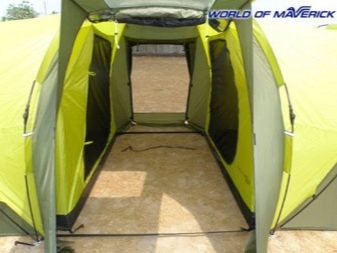
- No less popular is the one-room model Alexika Nevada 4, also made of polyester and accommodating four people. The bottom of the product is made of highly durable Oxford 150D material, which, together with the water-repellent coating of the awning, provides complete protection from rain and ultraviolet radiation. The tent has three exits and a huge vestibule, in which a table and four chairs can be freely placed. The weight of the model is 12.5 kg, the cost is 26,000 rubles.
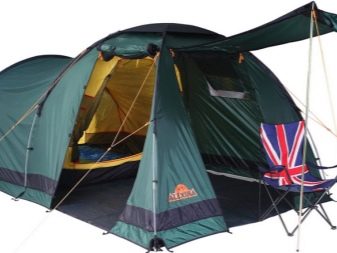
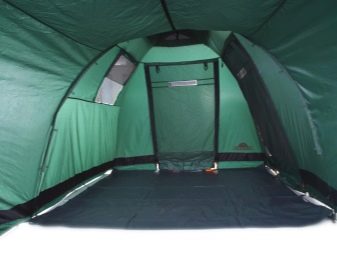
- The Galaxy World of Maverick model is also designed for four people. The framework of a product is unfolded mechanically and is made of aluminum. The tent has 5 windows and 2 entrances, and the assembly time is only 5 minutes. However, due to the rather large dimensions of the product, which are 535x380x195 cm, it is recommended to assemble it together. Such a model costs 29280 rubles.
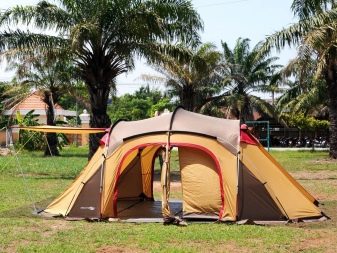
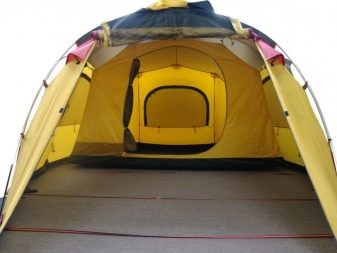
- Tramp BREST tent with 9 peopleTanet is an ideal option for a large company. The model consists of three rooms located on opposite sides of the vestibule. Each compartment has a ventilation window, and the entrance doors of all three rooms are equipped with a mosquito net. The awning of the product is treated with refractory impregnation, which provides reliable protection against accidental ignition. The weight of the model is 14.4 kg, the cost is 17,000 rubles.
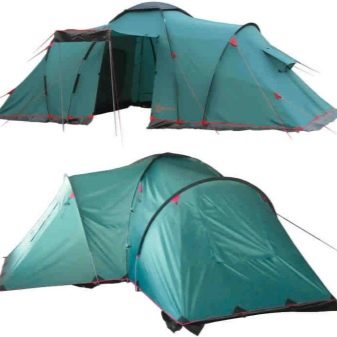

- Camping model Alexika Victoria 10 designed for 10 people and consists of two spacious rooms and a vestibule.The model is packed in two convenient bags and has a total weight of 28 kg. The awning is made of polyester and has taped sealed seams. The price of the tent is 55,000 rubles.
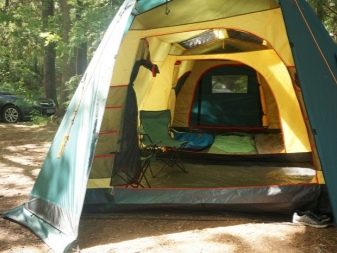

Selection Guide
When choosing a camping model, you need to pay attention to a number of important points.
First of all, you need to look at the frame. It is on him that the ease of use, trouble-free operation and service life of the tent depend. The best option is a steel frame.
The next selection criterion is the weight of the model. So, a 5-person tent weighs an average of 10 to 15 kg, but there are models of the same capacity, but with a higher weight. This is due to the materials of manufacture, the number of compartments and the dimensions of the product. The most voluminous models often weigh 20 or more kilograms.
This indicator should be paid attention to lovers of wild places, which cannot be reached by car, and part of the way has to be walked.
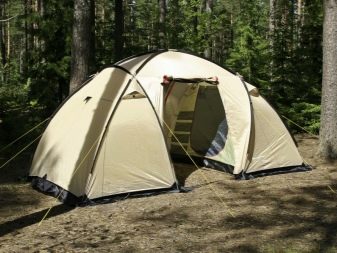

When choosing a model for camping, you should pay attention to the price. So, too cheap models for the most part go on a fiberglass frame, are made of non-breathable fabric and do not differ in the tightness of the seams. Often in such tents there is no ventilation, which is why sleeping bags will become damp from condensation. Moreover, such models often start to leak at the first rain and do not have a floor in a common vestibule.
If you plan to actively use the tent in a rainy climate, then you should choose models with a water resistance index of 600 to 1500 mm. Art. Such products are able to withstand up to 200 nights in the rain and even at the end of their service life they do not leak.
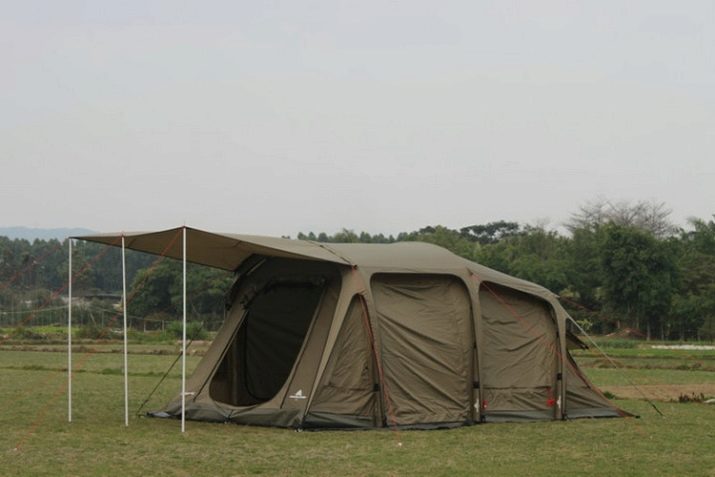
Top 10 camping tents, see the following video.























